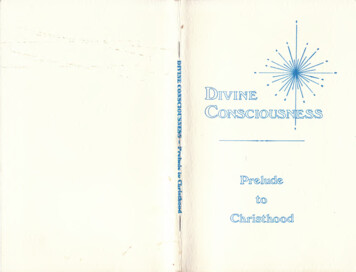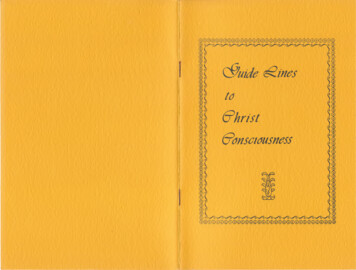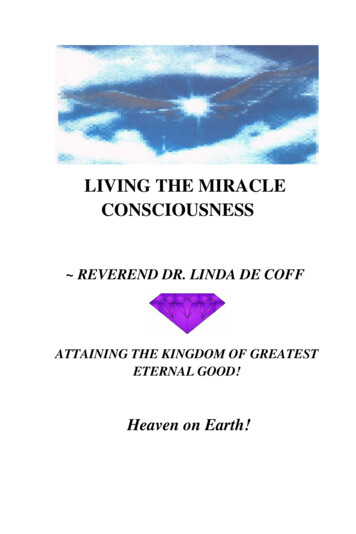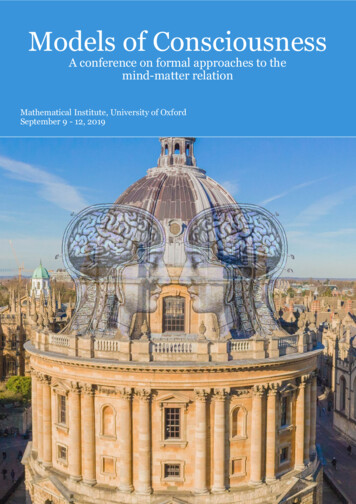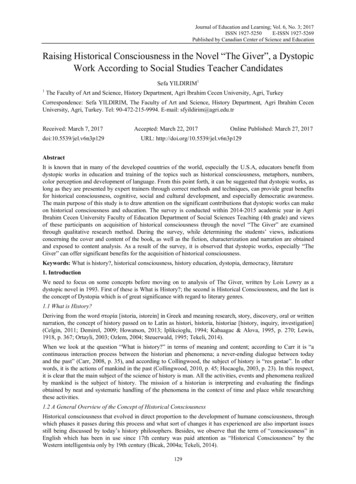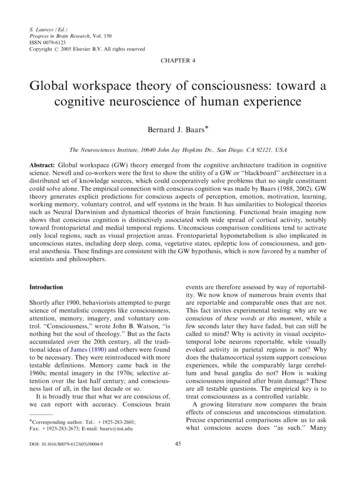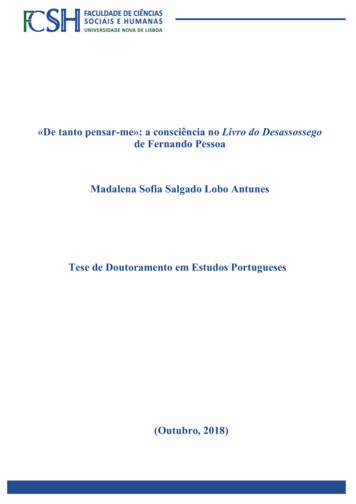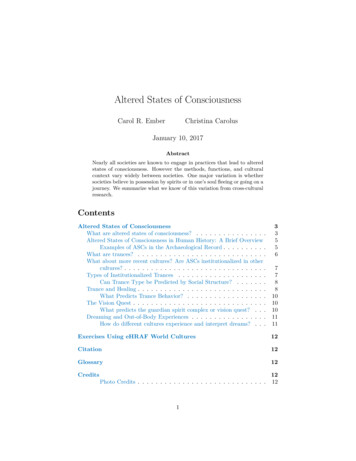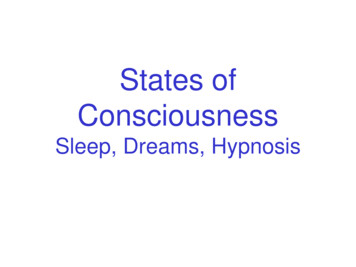
Transcription
States ofConsciousnessSleep, Dreams, Hypnosis
Circadian Rhythm From the Latin meaning about a day Waxing and waning ofconsciousness/alertness Actually closer to 25 hour cycle inhealthy young adults Class Survey – How many of you aremorning people? Afternoon people?Night owls?
Class Sleep SurveyHow many hours sleep do you need (nothow many you actually get) to wake upand feel refreshed?How many are we supposed to get?
Sleep ChartAverage Number Hours by Age
Theories Why We Sleep Sleep helps to reduce stimulation Strengthens memory, increasesconcentration, boosts mood, feeds creativethinking, moderates hunger & obesity,fortifies the immune system, lessens therisk of accidents Serves as a restorative process (especiallyNREM) – Helps restore & repair braintissue, gives resting neurons time to repairthemselves, pituitary gland releases growthhormone during sleep
Differences between REM & NREM
NREM Sleep More prevalent when we are physicallytired. Need NREM when depressed. NE, 5-HT, DA are produced duringNREM NREM dreams are thought-like, ofteninvolve conversation Stage N3 (Slow wave sleep, sleeptalking, sleep walking, sleep terrors inchildren)
REM Sleep (Paradoxical Sleep) Rapid eye movement, increased rate of respirationand heart-rate, EEG resembles wakefulness, erectionin males, vaginal lubrication in females NE, 5-HT, DA production is depressed during REM Dreams are story-like and full of action
Stages of Sleep
Sleep ChartNumber Hours Spent in REM vs. NREM
Why Do We Dream? Throughout history, people have beenfascinated with dreaming. Historically there was a tendency topresume that dreams mean something. Some of the earliest recorded incidentsof dream interpretation are mentioned inthe Old Testament.
Story of King NebuchadnezzarRecorded in Book of Daniel, 604 B.C.
King Nebuchadnezzar orders theexecution of all his advisors sincethey are unable to tell him his dreambefore their interpretation.
Freud’s Concept of the Personality Considered dreamsto be a highway intothe unconscious Content of dreamsis symbolic of wishfulfillment, oftensexual
So Much For Wish Fulfillment
Modern Dream Theories Filing (information processing)Physiological functionActivation synthesisCognitive development
Comparison of Dream Theories
Research to Test the TheoriesWhich Theory Has The Most Support?Fall 2006 Dream Research Filing (information processing) Activation synthesis Psychoanalytic
Findings of Previous Studies of Dreams ofCollege Students (1950 & 1980) They occurred in familiar settings Dreamers were usually in company ofsomeone they knew Aggressive encounters were slightly morecommon than friendly ones Misfortune and failure occurred more oftenthan success Apprehension was the most common emotion Sexual content was reported in only 12% ofthe dreams of males and 4% of females
Dreams of Blind People Although most people’s dreams are primarilyvisual, blind people’s dreams contain a muchmore diverse array of sensory information. In one study of blind subjects versus sightedcontrols, 70% of blind subjects experienced atouch sensation, versus 45% of sightedcontrols. 86% of blind subjects reportedhearing in at least one dream compared to64% of controls. 18% of the blind subjectstasted, compared to 7% of controls. 28%smelled compared to 15% of controls.
Dreams of Blind People In consideration of only subjects who werecongenitally blind, 93% heard, 26% tasted,40% smelled, & 67% reported touchsensation in dreams. Emotional & thematic content is not all thatdifferent between blind & sighted persons.They report the same number of successes,failures, & social interactions, and experiencethe same frequency & intensity of emotion, &almost equal levels of bizarreness.
Dreams of Blind People Congenitally blind people report far morenightmares (25%) than do sighted individuals(6%) or individuals who become blind duringtheir lives (7%). Nightmares of congenitallyblind subjects reflected threats they face intheir waking lives (i.e., being run over by acar, getting lost, falling in holes atconstruction sites).
Discovering Psychology on YouTube Discovering Psychology: The Mind Awake & Asleep (10:3325:06) The Power of Naps
Sleep Disorders Sleep terror disorder– Common during earlychildhood– Occurs during Stage 3NREM sleep– No need to treat Narcolepsy– Individual falls asleep inmidst of activity– Goes straight fromwakefulness to REM– Treated with stimulantslike Provigil Sleep Apnea– Individual stops breathing– Snoring– Treatment includes: Refraining fromsleeping in supineposition (do not sleepon back) Use of CPAPmachine (ContinuousPositive AirwayPressure) CPAP PRO
InsomniaHow long does it take you to fall asleep? Sleep Onset– We may alloccasionally havetrouble falling asleep– Regularly takes morethan 10-15 minutesto fall asleep Early MorningAwakening– Falls asleep easilybut then wakes upafter a few hours andcannot get back tosleepMANY INSOMNIACS SUFFER FROMBOTH CONDITIONS
You May Be Getting More Sleep Than You Think People tend to misjudge how long it takes them to fallasleep & how often they wake up during the night. 30% of American adults have symptoms of insomnia.Women are about 50% more likely to have insomniathan men. Risk increases with age. 10% of the population has chronic insomnia. Half of people with insomnia, when studied in a sleeplab, actually get 6 hours of sleep a night. By contrast, people who don’t sleep muchoverestimate how much they sleep. In the sleep labat Penn State, most people estimated they sleepbetween 7 to 8 hours. When studied in the lab, theytypically slept 6 hours.
Treating Insomnia Over-the-counter medications– Mostly antihistamines Sedating Rx medications– Minor tranquilizers (highly addictive; e.g.Ativan, Valium, Xanax)– Hypnotics (can be habit forming; e.g.,Halcion, Lunesta, Ambien)– Tricyclic antidepressants (designed todepress REM, very sedating; e.g., doxepin,amitriptylene)
Behavior Therapy of Insomnia1. Only use bed for sleeping Do not turn bed into activity center2. Only go to bed when sleepy If unable to fall asleep within about 10 minutes,get up and go into another roomWhen drowsy, drag self to bedImportant to establish bed as a cue forsleeping3. Always get up at the same time every day,including weekends4. Do not nap during the day time (exceptpower naps)
Hypnosis The Eyes Have It (Donald Duck Hypnotizes Pluto) Most useful in pain control Controversial use is recovery of lost memories fromthe unconscious Discovering Psychology: The Mind Divided (6:5519:00) Unusual Personal Experiences,Alien Abduction, John Mack, M.D.
Near Death Experiences Life After Life, Raymond Moody, M.D. The Case of Dr. Eben Alexander: ATrue Story NPR Episode
1. Only use bed for sleeping Do not turn bed into activity center 2. Only go to bed when sleepy If unable to fall asleep within about 10 minutes, get up and go into another room When drowsy, drag self to bed Important to establish bed as a cue for sleeping 3. Always get up at the same time every day, including weekends 4.
